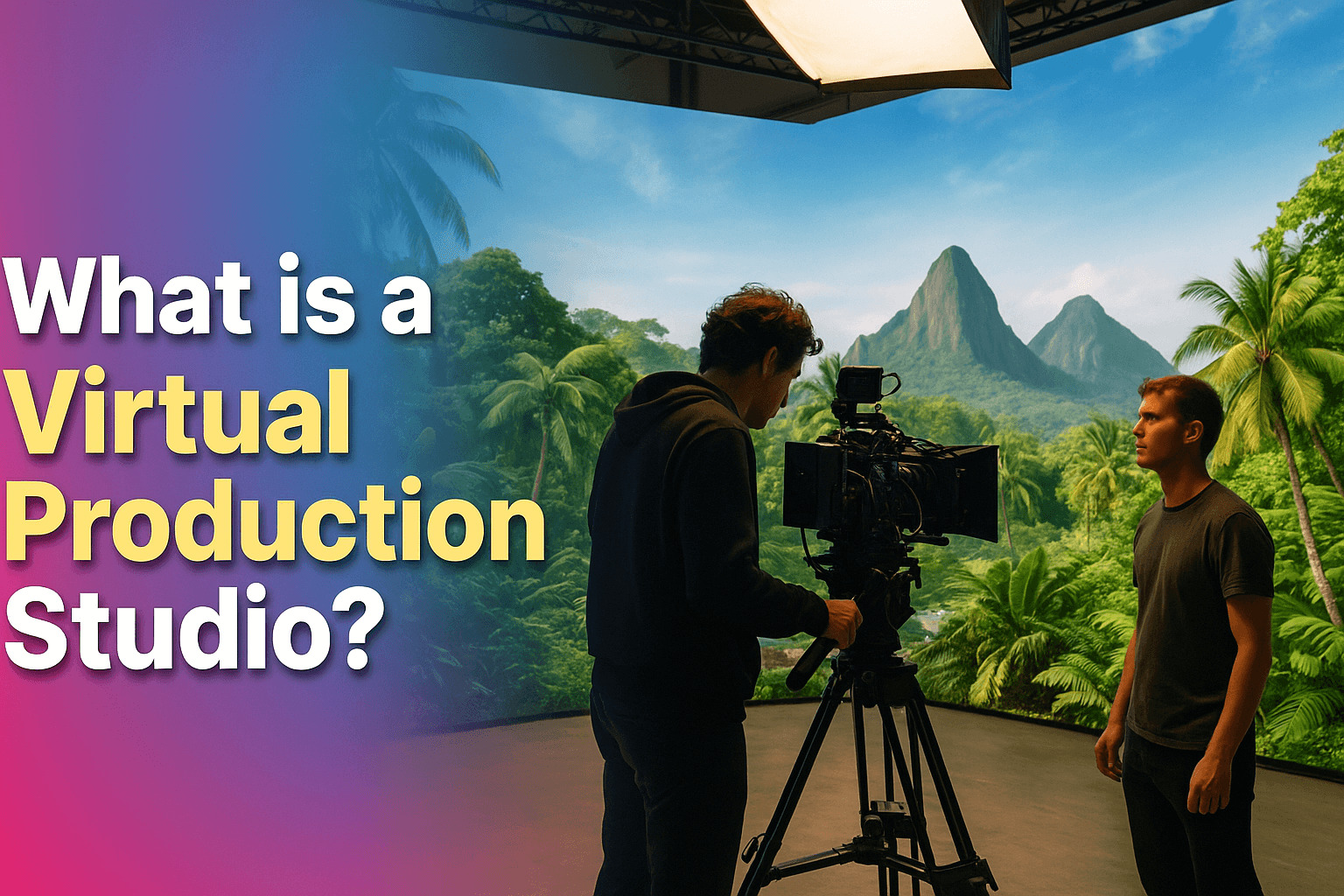What is a Virtual Production Studio? A Definitive Guide

Introduction
In a media and entertainment industry defined by accelerating innovation, few technologies have been as transformative as virtual production. The global virtual production market is projected to reach an estimated USD 14.2 billion by 2034, signifying a fundamental shift in how content is created.
However, for a senior executive, this rapid evolution presents a significant challenge:
The market is new, highly fragmented, and technically complex. Understanding what a virtual production studio is—and, more importantly, how to leverage its capabilities—is a strategic imperative. This article provides a definitive guide, explaining the technology, its business advantages, and the key players driving its adoption. In my analysis, navigating this emerging sector effectively requires a data platform like Vitrina, which provides the real-time, verified intelligence needed to find and connect with the right partners.
Table of content
- From Green Screen to Real-Time Volume: The Evolution of VFX
- The Strategic Advantages of a Virtual Production Studio
- Notable Productions and Key Players in Virtual Production
- Navigating the Challenges of Virtual Production
- How Vitrina Helps You Navigate the Virtual Production Studio Market
- Conclusion
- FAQs
Key Takeaways
| Core Challenge | The high upfront costs and technical complexity of virtual production, compounded by the difficulty of finding specialized studios and talent in a fragmented market. |
| Strategic Solution | Understand the technology’s core components and key business advantages to make a proactive, informed decision about adoption and partnership. |
| Vitrina’s Role | Vitrina provides the centralized data to find and vet key players and emerging talent in the virtual production space, transforming a new-frontier scouting process into a streamlined one. |
From Green Screen to Real-Time Volume: The Evolution of VFX
For decades, the standard method for compositing live action with a digital background was the green screen. While effective, this process was linear and time-consuming: actors performed against a blank canvas, and the digital background was added much later in post-production, often leading to costly reshoots and creative mismatches. The defining characteristic of a modern virtual production studio is its ability to eliminate this siloed workflow by integrating the digital and physical worlds in real time.
The core technology behind this revolution is the LED volume —a massive, immersive display made of interconnected LED panels that can wrap around a set or fill an entire studio. These walls serve as a dynamic background, powered by a real-time rendering engine like Unreal Engine or Unity.
The final piece of the puzzle is a camera tracking system that communicates with the game engine, ensuring that the background visuals dynamically adjust to the camera’s movements in perfect sync. This creates an immersive experience where the final visual is captured “in-camera” on set, not in a server farm months later.
The Strategic Advantages of a Virtual Production Studio
Beyond the technical wizardry, virtual production offers a suite of compelling business advantages that directly address the pain points of modern production. The primary benefit is cost and time efficiency. By eliminating the need for expensive location scouting, travel, and set construction, virtual production significantly reduces a project’s budget and footprint. Since the final pixel can be captured on set, a considerable amount of post-production work and costs are also reduced.
Another major advantage is creative freedom. Directors, cinematographers, and producers can make instant, real-time adjustments to a scene’s lighting, time of day, or environment without waiting for designers to rebuild a physical set.
This level of control and flexibility allows for greater experimentation and can lead to better creative outcomes. Furthermore, the technology enhances actor performance by allowing talent to react to and interact with a tangible, immersive environment rather than a blank green screen.
Notable Productions and Key Players in Virtual Production
The mainstream adoption of virtual production was largely accelerated by the success of Disney+’s “The Mandalorian,” which used the technology to create its photorealistic alien worlds and save significant costs on location shoots. However, this technology is no longer exclusive to a handful of blockbuster productions. In fact, it is increasingly being used by a wide array of content creators.
Examples of successful virtual production projects include:
- “The Witcher” (Netflix): The series used a combination of virtual sets and CGI to create elaborate fantasy worlds on a television budget.
- “The Midnight Sky” (Netflix): The film used virtual production to create vast arctic wilderness scenes from within a controlled studio environment.
- “The Matrix Resurrections“: The production extensively relied on virtual production to create high-octane action sequences set in intricate digital environments.
This trend is indicative of a market that is democratizing its technology, making virtual production more accessible for a wider range of studios and filmmakers. The demand for this technology is growing globally, with the virtual production market for movies and television expected to reach a value of USD 1.3 billion in the U.S. and USD 1.0 billion in Europe in 2025.
Navigating the Challenges of Virtual Production
Despite its significant advantages, adopting virtual production presents its own set of challenges. The initial upfront investment in specialized hardware and software is still a major barrier to entry for many studios. A full-scale LED volume with camera tracking and powerful rendering computers requires a significant capital investment. Furthermore, the technology demands a workforce with a highly specialized skillset, blurring the traditional lines between on-set roles and post-production artistry.
There are also technical hurdles. A production must be meticulously planned in pre-production, as even seemingly minor technical issues can lead to major problems on set. Common technical challenges include color shifts, moiré patterns, and tracking delays, which require a high level of technical expertise to avoid. For an executive, the challenge is not just finding a studio with the technology, but also finding the specialized talent and crew who can work effectively in this new workflow.
How Vitrina Helps You Navigate the Virtual Production Studio Market
The strategic value of virtual production is clear, but leveraging it requires a powerful tool. My analysis shows that Vitrina is uniquely positioned to empower executives with the intelligence needed to operate in a rapidly evolving market. It provides the crucial, real-time data that traditional methods lack.
- Pinpoint Specialized Partners: Vitrina’s global search engine lets you precisely filter for virtual production studios and vendors based on their technical capabilities and past projects. This allows you to find partners with a proven track record of using specific technologies like LED volumes and game engines.
- Vet with Confidence: The platform’s real-time project tracker links companies directly to the films and series they have worked on, providing a clear, data-backed view of their entire portfolio. This intelligence helps you vet a company’s reliability before you ever make contact.
- Connect with Decision-Makers: A great studio is useless without the right crew and executives. Vitrina provides access to over 3 million verified decision-makers and executives, tagged by department and specialization, ensuring you can connect with the right person from the start.
Conclusion
In conclusion, a virtual production studio is more than a technological fad—it is a strategic asset that transforms the entire filmmaking process. While the technology presents challenges related to cost and complexity, its advantages in efficiency, creative control, and on-set performance are undeniable. As the market continues to grow, adopting a data-driven approach to finding and vetting partners is no longer optional.
The most successful executives will be those who can move with speed and precision, using a platform like Vitrina to navigate a fragmented market. By centralizing real-time information on specialized studios, key projects, and decision-makers, it provides the clarity and insight needed to make confident, informed decisions.
It transforms the complex task of scouting a new technology and its collaborators into a streamlined and strategic process, ensuring your organization can capitalize on the vast potential of the virtual production market.
Frequently Asked Questions
With a green screen, the digital background is composited in post-production, which means the actors and crew cannot see it on set. Virtual production, by contrast, uses large LED walls to display the background in real time, allowing actors and directors to see the final environment and make instant adjustments.
While virtual production has high upfront costs for equipment and setup, it often results in significant savings in the long run. It reduces or eliminates expenses related to location scouting, travel, and extensive post-production, making it a more cost-effective method for many projects.
A typical virtual production stage includes an LED volume (the large display walls), a real-time rendering engine (such as Unreal Engine) that powers the visuals, and a camera tracking system that syncs the digital environment with the camera’s movements.
An LED volume is a term for the large, immersive screen made of LED panels that serves as the dynamic background in a virtual production studio. It is a key component of the technology as it provides a realistic, light-emitting environment for actors to perform in.















































